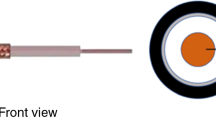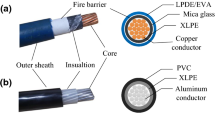Abstract
The gas sensor method is a new method to realize cable fire detection for the advantages of small size, high sensitivity, and quantitative detection of gas. To this end, the pyrolysis characteristics of the PE outer sheath of high-voltage cables were determined via the oxygen consumption method. The results reveal that a strong correlation between various fire index parameters and the heat flux of PE cable pyrolysis. And the ratio of CO and CO2 generated by the pyrolysis of the outer sheath of the cable may be the key to the early detection of PE cable fire. All the works provide experimental foundation for the establishment of the high voltage cable fire early warning method based on the pyrolysis gases.







Similar content being viewed by others
References
Bian H et al (2020) Improved physical model of electrical lifetime estimation for crosslinked polyethylene AC cable. IEEE Trans Dielectr Electr Insul 27(1):132–139
Tantipattarakul S, Vaughan AS, Andritsch T (2020) Ageing behaviour of a polyethylene blend: influence of chemical defects and morphology on charge transport. High Volt 5(3):66
Abdel-Gawad NMK, El Dein AZ, Mansour D-EA, Ahmed HM, Darwish MMF, Lehtonen M (2020) PVC nanocomposites for cable insulation with enhanced dielectric properties, partial discharge resistance and mechanical performance. High Volt 5(4):66
Boxue D, Bin C, Hang X et al (2018) Arc resistance and dielectric properties of polyethylene/boron nitride composites with high thermal conductivity. High Volt Eng 44(5):1412–1420
Nakamura Y, Yoshimura N, Ito H, Azumaya K, Fujita O (2008) Flame spread over electric wire in sub-atmospheric pressure. Proc Combust Inst 32(2):66
Wang Z, Wang J (2020) A comprehensive study on the flame propagation of the horizontal laboratory wires and flame-retardant cables at different thermal circumstances. Process Saf Environ Protect 6:66
Zhang BS, Zhang JQ, Li Q et al (2018) Effects of insulating material ageing on ignition time and heat release rate of the flame retardant cables. Procedia Eng 211:972–978
Wang C, Liu H, Zhang J et al (2018) Thermal degradation of flame-retarded high-voltage cable sheath and insulation via TG-FTIR. J Anal Appl Pyrolys 134:167–175
Xue MY, Lu YH, Li K et al (2019) Thermal characterization and kinetic analysis of polyvinyl chloride containing Sn and Zn. J Therm Anal Calorim 139:1–2
Bene M, Milanov N, Matuschek G et al (2004) Thermal degradation of PVC cable insulation studied by simultaneous TG-FTIR and TG-EGA methods. J Therm Anal Calorim 78(2):621–630
Zhou J, Liu G, Xu F et al (2020) TG-FTIR and Py-GC/MS study of the pyrolysis mechanism and composition of volatiles from flash pyrolysis of PVC. J Energy Inst 6:66
Courty L, Garo JP (2017) External heating of electrical cables and auto-ignition investigation. J Hazard Mater 321:528–536
Liang L, Cheng D, Shengchang J et al (2022) Overview of ignition mechanism and combustion characteristic of wire and cable. High Volt Eng 48(2):612–625. https://doi.org/10.13336/j.1003-6520.hve.20201638
Liu WL, Wang A et al (2018) Flammability and flame-retardant mechanism of high density polyethylene/wood fiber/modified ammonium polyphosphate composite. Polym Compos 39(4):1192–1199
Miyamoto K, Huang XY, Hashimoto N, Fujita O, Fernandez-Pellob C (2016) Limiting oxygen concentration (LOC) of burning polyethylene insulated wires under external radiation. Fire Saf J 86:66
Nakamura Y, Yoshimura N, Ito H, Azumaya K, Fujita O (2004) Flame spread over electric wire in sub-atmospheric pressure. Proc Combust Inst 32(2):66
Wu J, Chen T, Luo X et al (2014) TG/FTIR analysis on co-pyrolysis behavior of PE, PVC and PS. Waste Manag 34(3):676–682
Xiao M, Liang D, Shen H (2016) Research on flame retardancy and combustion characteristics of PE and PE-MH-NC cable materials. Procedia Eng 135:243–247
Honus S, Kumagai S, Fedorko G et al (2018) Pyrolysis gases produced from individual and mixed PE, PP, PS, PVC, and PET-Part I: production and physical properties. Fuel 221:346–360
Fontaine G, Ngohang FE, Gay L et al (2017) Investigation of the contribution to fire of electrical cable by a revisited mass loss cone. Springer, Singapore, pp 687–693
Andritsch T, Vaughan A, Stevens GC (2017) Novel insulation materials for high voltage cable systems. IEEE Electr Insul Mag 33(4):27–33
El Gazi M, Sonnier R, Giraud S, Batistella M, Basak S, Dumazert L, Hajj R, El Hage R (2021) Fire behavior of thermally thin materials in cone calorimeter. Polymers 13(8):66
Meinier R, Sonnier R, Zavaleta P, Suard S, Ferry L (2018) Fire behavior of halogen-free flame retardant electrical cables with the cone calorimeter. J Hazard Mater 342:66
Magalie C, Anne-Sophie C, Rodolphe S, Laurent F, Emmanuelle G, Christian L (2018) Fire behaviour of electrical cables in cone calorimeter: influence of cables structure and layout. Fire Saf J 99:12–21
Martinka J, Rantuch P, Sulová J, Martinka F (2019) Assessing the fire risk of electrical cables using a cone calorimeter. J Therm Anal Calorim 135(6):3070–3083
Katarzyna K-C, Jadwiga F, Papis BK (2021) Calorimetric behaviour of electric cables. Energies 14(4):66
Acknowledgements
This study was funded by Science and Technology Research Program of Chongqing Municipal Education Commission (Grant No. KJQN202001524, Grant No. KJZD-K202001505), and Chongqing Natural Science Foundation (Grant No. cstc2020jcyj-msxmX0267).
Author information
Authors and Affiliations
Corresponding author
Ethics declarations
Conflict of interest
The authors declare that there is no conflict of interest regarding the publication of this paper.
Additional information
Publisher's Note
Springer Nature remains neutral with regard to jurisdictional claims in published maps and institutional affiliations.
Rights and permissions
Springer Nature or its licensor holds exclusive rights to this article under a publishing agreement with the author(s) or other rightsholder(s); author self-archiving of the accepted manuscript version of this article is solely governed by the terms of such publishing agreement and applicable law.
About this article
Cite this article
Zhou, C., Cao, Z., Wei, G. et al. Research on Pyrolysis Characteristics of PE Outer Sheath of High-Voltage Cables Based on the Principle of Oxygen Consumption. J. Electr. Eng. Technol. 18, 679–685 (2023). https://doi.org/10.1007/s42835-022-01178-0
Received:
Revised:
Accepted:
Published:
Issue Date:
DOI: https://doi.org/10.1007/s42835-022-01178-0




